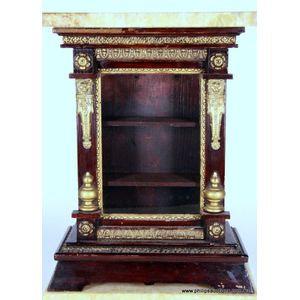Louis XVI style miniature vitrine
You must be a subscriber, and be logged in to view price and dealer details.
Subscribe Now to view actual auction price for this item
When you subscribe, you have the option of setting the currency in which to display prices to $Au, $US, $NZ or Stg.
- Onyx - Onyx is a form of agate, used from antiquity and popular again in the 1920s and 30s. European onyx is generally green, but can be many other colours, and can contain bands of black and/or white.
This multicoloured stone is widely used for table tops, lamp bases and in jewellery. Some types of onyx are also used for cameos of which the upper white layer is cut away to reveal the colour beneath. - Alabaster - Alabaster is soft natural stone used for statuary, with a similar appearance to marble, but easier to work with. As it is softer than marble, an item made from alabaster can be scratched with a metal object, and an alabaster item does not polish to a high surface gloss like marble.
Alabaster objects can be semi-translucent. Alabaster occurs in a pure white form and also with veining from dirt. Colours vary from white through yellow and pink to brown. The veining is usually green or black but can be multicoloured.
Being semi-translucent, alabaster is often used for the bowls of figural lamps, with the figure itself being either alabaster or marble. - Cornice - The upper section of a high piece of furniture such as a bookcase, wardrobe or cabinet that sits immediately on the main structure. The cornice is usually decorated with a variety of architectural mouldings, worked either with a moulding plane or, from the later 19th century, by machine. The front and side of the cornice are mitred together, strengthened by glue blocks, and the back is generally a simple dovetailed rail to hold the structure together. Cornices are generally, though not always, fitted separately to the piece and are held in place either by screws sunk into the top board or by wooden corner blocks. A pediment may sit above the cornice, but sometimes the terms cornice and pediment are used interchangeably.
This item has been included into following indexes:
Visually similar items

A miniature display cabinet, in the form of an antique pier cabinet with a marble slab top above a glazed door enclosing shelves, on a spreading base and marble slab foot, carved and applied gilt decoration throughout. Height 40 cm. Width 30 cm. Depth 15 c

A longcase mahogany clock by James Chatter & Sons, London c. 1760 with strike and silent, Clockmaker's premises: 3 cherry tree court, Alders gate, London. Operating from 1754 - 1759., clock displays seconds, minutes, hours and day of the month, 260 cm high

A George III red lacquer Chinoiserie decorated longcase clock J Stansbury, Leominster English 18th century

A 19th century oak cased long case clock, Henry Watson, Blackburn, with brass dial Roman numerals and arcaded Arabic seconds, subsidiary calendar 218 cm high
